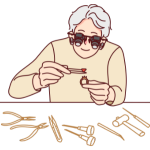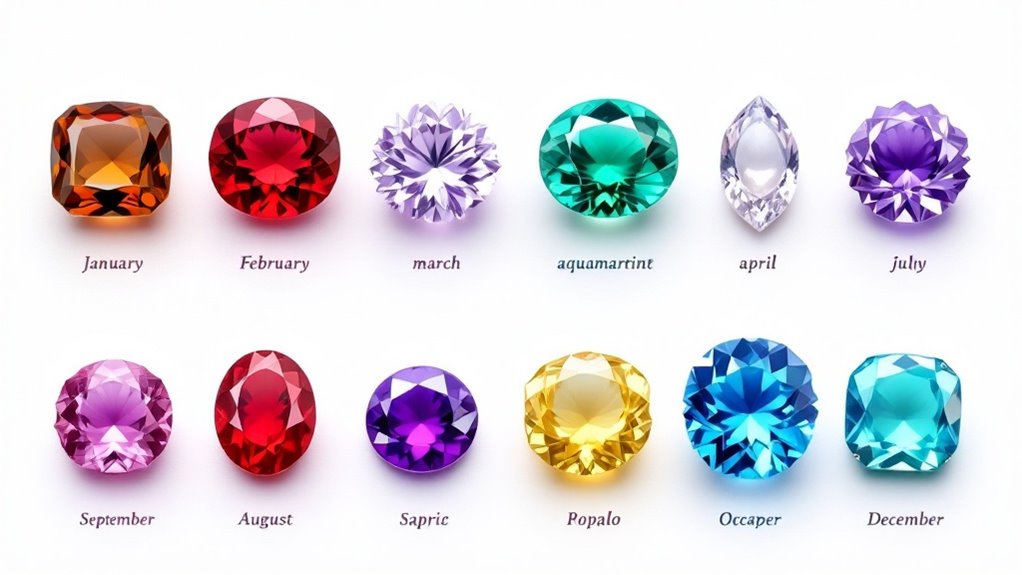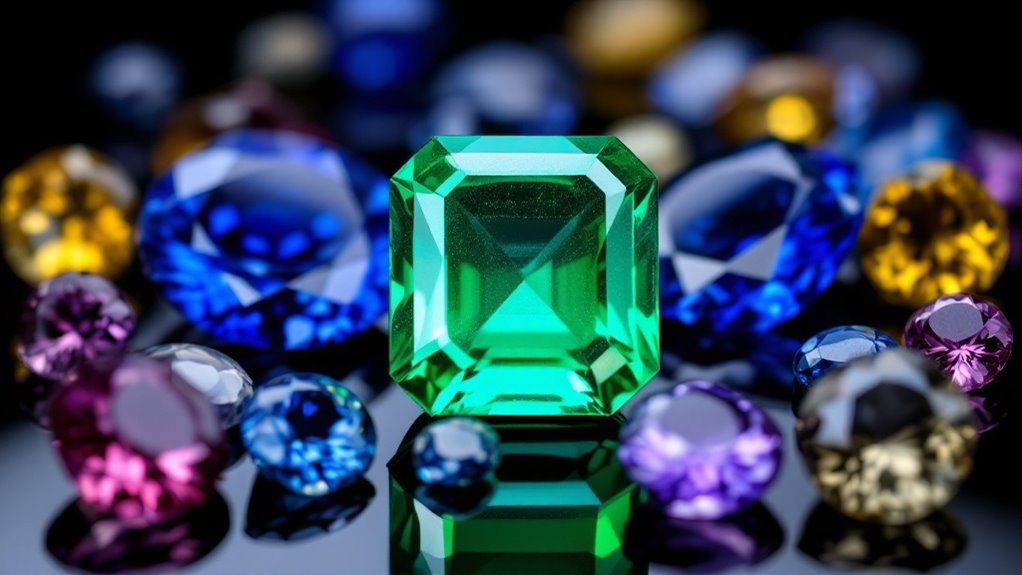Selecting the best wire types for jewelry wrapping involves understanding their distinct characteristics. Copper wire is affordable and malleable. Fine silver offers purity and softness. Argentium silver and sterling silver present durability and tarnish resistance. Gold filled wire combines luxury with affordability. Plated, enamel-coated, and anodized wires provide cost-effective color options. Ultimately, aluminum wire is lightweight and easy to handle. These options meet diverse crafting needs, and further insights can reveal ideal choices for specific projects.
Copper Wire
Copper wire stands out as a popular choice for jewelry wrapping due to its affordability and ease of manipulation. Favored particularly by beginners, copper wire for jewelry is accessible and versatile. Available in various gauges, it accommodates both delicate and sturdy designs, with 24 gauge commonly used for general wrapping. Its rich red hue adds a rustic charm, enhancing designs with natural stones and earthy themes. Over time, copper develops a patina, offering a vintage appeal; artisans can also polish it to retain its shine. Its malleability allows it to be easily coiled, twisted, and shaped for diverse techniques.
Fine Silver Wire
Fine silver wire, known for its composition of 99.9% pure silver, offers exceptional softness and malleability, making it ideal for intricate jewelry wrapping designs. Its resistance to firestain during heating guarantees a cleaner finish than sterling silver, enhancing the quality of the final piece. This wire’s ability to hold shapes without brittleness makes it particularly suitable for wire weaving and wrapping techniques.
Softness and Malleability
Among the various materials used in jewelry making, fine silver wire stands out for its exceptional softness and malleability. Composed of 99.9% pure silver, this wire allows for intricate wire wrapping techniques that appeal to both beginners and experienced artisans. Its softness enables effortless bending and shaping, making it perfect for crafting delicate designs.
| Property | Description | Benefit |
|---|---|---|
| Purity | 99.9% pure silver | High malleability |
| Texture | Soft and pliable | Easy to shape |
| Purchase Method | Sold by centimeter | Cost-effective for projects |
These qualities make fine silver wire a favored choice for elegant, complex jewelry creations.
Firestain Resistance
While crafting intricate wire-wrapped jewelry, artisans often value materials that maintain a pristine appearance under heat. Fine silver wire for wrapping is favored for its exceptional firestain resistance. Composed of 99.9% pure silver, it lacks the copper content found in sterling silver, which typically causes firestain upon heating. This absence guarantees a cleaner, aesthetically pleasing finish in finished pieces. Additionally, fine silver wire’s malleability allows for effortless manipulation into delicate shapes without compromising its integrity. Sold by the centimeter, it offers jewelry makers the flexibility to purchase only what they need, thereby minimizing both waste and cost efficiently.
Ideal for Wrapping
Building on the benefits of firestain resistance, fine silver wire is regarded as ideal for wrapping due to its exceptional malleability and purity. Composed of 99.9% pure silver, it offers jewelers the ability to explore intricate designs without fire scale risk. Its softness allows for flowing curves, enhancing jewelry aesthetics. Compared to sterling silver, fine silver tarnishes less and is easier to manipulate, making it a preferred choice for detailed projects.
| Feature | Benefit |
|---|---|
| Purity | 99.9% pure silver |
| Malleability | Enables intricate designs |
| Tarnish Resistance | Slower tarnishing than sterling |
| Gauge Variety | Ranges from 20 to 32 gauge |
Fine silver wire for wrapping requires work hardening for durability.
Argentium Silver Wire
Argentium silver wire stands out in jewelry making due to its tarnish-resistant properties, offering a bright white color that maintains its luster with minimal upkeep. Its enhanced durability, compared to traditional sterling silver, makes it an appealing choice for artisans seeking both beauty and longevity in their creations. This combination of features guarantees that jewelry pieces retain their allure over time, even with frequent wear.
Tarnish-Resistant Properties
Known for its exceptional tarnish-resistant properties, Argentium silver wire stands out in the world of jewelry making. As a tarnish-resistant wire for jewelry, it comprises 93.5% or 96% pure silver, offering artisans a high-quality material that maintains its brilliance. Unlike traditional sterling silver, Argentium contains germanium, greatly reducing tarnishing and making it easier to preserve its bright white color over time. This consistency eliminates the yellowish hue that sterling silver can develop when exposed to air. Available in dead soft and half-hard forms, it offers flexibility in design, ensuring that jewelry pieces remain visually appealing for longer durations.
Enhanced Silver Durability
While Argentium silver wire is celebrated for its tarnish-resistant qualities, its enhanced durability further elevates its appeal in jewelry making. Comprising 93.5% or 96% silver, this alloy surpasses standard sterling silver in strength. The inclusion of germanium not only boosts its resilience against tarnishing and fire scale but also reduces maintenance needs. Its malleability allows for intricate wire wrapping without sacrificing structural integrity, thanks to heat hardening capabilities. Available in various gauges, this silver wire for wrapping suits both delicate and robust designs. Consequently, Argentium silver wire is an ideal choice for crafters seeking long-lasting, versatile jewelry components.
Sterling Silver Wire
Sterling silver wire, composed of 92.5% pure silver, is prized for its durability and resistance to tarnishing, making it a premier choice for high-quality jewelry wrapping. Available in gauges from 18 to 26, it offers flexibility for crafting sturdy clasps and delicate wraps. This wire can be work-hardened, enhancing its strength for components requiring structural integrity. Its compatibility with various techniques like wrapping, weaving, and coiling allows for intricate designs. While it may develop fire scale when heated, its ability to retain shape under stress makes sterling silver wire for wrapping a preferred option among experienced jewelers.
Gold Filled Wire
Gold filled wire offers a compelling alternative to solid gold for jewelry wrapping, combining affordability with durability. Consisting of a base metal, typically brass or copper, bonded with a thick layer of gold, this wire is more durable and cost-effective than solid gold. The gold layer, comprising at least 5% of the total weight, markedly enhances its longevity compared to gold-plated options. Resistant to tarnishing and avoiding chipping or peeling, gold-filled wire for jewelry is ideal for pieces experiencing frequent wear. Its luxurious appearance suits various applications, ensuring both beginner and experienced artisans enjoy a high-quality, enduring material.
Brass Wire
Brass wire, often referred to as Jewelers Brass or Nu Gold, is a versatile material favored in jewelry making for its resemblance to 14K yellow gold. As one of the best wire for jewelry wrapping, it provides an appealing, luxurious look at a fraction of the cost. However, its zinc content makes it harder and springier than copper, which can limit its workability for intricate designs. Importantly, brass wire may discolor or behave unpredictably when heated, complicating techniques like soldering. While cost-effective, it is not recommended for those with metal allergies, as it can cause reactions similar to nickel.
Plated Wire
Plated wire offers a practical and cost-effective solution for jewelry makers seeking the appearance of solid precious metals without the associated expense. This jewelry wire type features a copper core coated with a layer of precious metal, such as silver or gold, creating an affordable yet appealing alternative. The thickness of the plating impacts durability; higher-quality options reduce the likelihood of the base metal showing through. While plated wire is less expensive, it can chip or scratch, potentially revealing copper underneath. It is popular among beginners due to its affordability and versatility in various gauges, though unsuitable for heavy manipulation.
Enamel-Coated Wire
Enamel-coated wire, renowned for its vibrant and durable finish, is a favored choice among jewelry makers seeking both aesthetic appeal and practicality. Artistic wire for jewelry, such as the popular Artistic Wire®, features a copper core enveloped in enamel, offering flexibility and a spectrum of colors. This wire resists chipping and tarnishing, making it suitable for frequently worn pieces. Available in various gauges, it accommodates both delicate and robust designs. However, it is not ideal for heavy manipulation or hammering.
| Feature | Benefit | Consideration |
|---|---|---|
| Vibrant Finish | Aesthetic appeal | Avoid heavy manipulation |
| Copper Core | Flexibility and strength | Not for hammering |
| Tarnish Resistant | Longer-lasting jewelry | Care in handling required |
Anodized Wire
Anodized wire offers a spectrum of durable color options, achieved through a chemical bath process that enhances aluminum wire with a protective, vibrant layer. This treatment not only provides visual appeal but also increases the wire’s resistance to tarnishing, making it ideal for jewelry projects that require lasting color. While its lightweight nature suits decorative applications, it may not be suitable for heavier or more intricate wirework.
Durable Color Options
While exploring vibrant and durable color options for jewelry wrapping, one notable choice is the use of anodized wire. This durable wire for jewelry boasts a protective oxide layer applied to aluminum, resulting in vivid colors that resist tarnishing. Its lightweight nature makes it perfect for intricate designs without adding unnecessary heft. Available in various gauges, anodized wire offers flexibility, supporting both delicate and sturdy applications. The anodizing process enhances resistance to scratches and chips, ensuring colors remain vibrant even after manipulation. Widely used in wire wrapping and beading, it provides a colorful alternative to traditional metals like copper and silver.
Chemical Bath Process
Through a meticulous chemical bath process, anodized wire achieves its renowned durability and vibrant color. This process involves immersing the wire in an electrolytic solution, forming a tightly adhered oxide layer on the metal’s surface. Unlike plated wires, anodized wire’s color is integrated into the surface, enhancing its longevity and making it scratch-resistant. Available in a spectrum of colors, it is a popular choice for decorative jewelry applications. Its corrosion resistance makes it ideal for outdoor use. Anodized wire consequently offers a durable, colorful option for wire wrapping techniques, ensuring the jewelry maintains its aesthetic over time.
Aluminum Wire
Aluminum wire serves as a popular choice for jewelry wrapping due to its lightweight nature and resistance to tarnishing, making it particularly appealing for hobbyists and beginners. This craft wire for jewelry is available in a spectrum of vibrant colors through anodization, fostering creative designs. Its softer texture allows for easy bending and shaping, suitable for intricate wrapping techniques. Available gauges range from 12 to 24, catering to diverse projects. However, its affordability comes with less durability, making it ideal for non-structural pieces.
| Feature | Description | Ideal Use |
|---|---|---|
| Weight | Lightweight | Easy to handle |
| Durability | Less durable than precious metals | Low-wear projects |
| Color Variety | Anodized for vibrant designs | Creative, colorful jewelry |
Conclusion
In conclusion, selecting the right wire type is essential for achieving the desired aesthetic and functionality in jewelry wrapping. Copper wire offers affordability and versatility, while fine silver and Argentium silver provide elegance and tarnish resistance. Sterling silver and gold-filled wires add a touch of luxury, and plated wire offers cost-effective options for experimenting with colors. Enamel-coated, anodized, and aluminum wires provide vibrant color choices and lightweight designs. Each wire type presents unique benefits, catering to diverse artistic visions and craftsmanship needs.





Leave a Reply